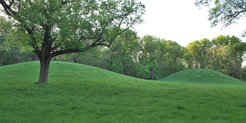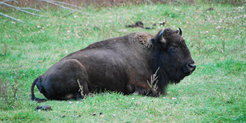Department of Archaeology Contributes to the Anthropocene Curriculum
The Mississippi: An Anthropocene River initiative seeks to explore the ecological, historical, and social interactions between humans and the environment across the Mississippi River Basin. Scholars from both sides of the Atlantic are working directly with local and international scientists, social theorists, artists, and activists with interests and backgrounds spanning the biological and social sciences as well as the humanities and visual arts.
The Department of Archaeology at the Max Planck Institute for the Science of Human History has teamed up with researchers from the Max Planck Institute for the History of Science and the Haus der Kulturen der Welt in Berlin, to better understand the extent of human impacts on the ecology of the Mississippi. The Anthropocene River initiative has proven to be an exemplary experiment in mingling intellectuals with diverse ways of thinking and ultimately producing a product greater than the sum of the constituent parts. Members of the Department of Archaeology have presented research at Anthropocene River conferences in Berlin and St. Louis, and three ongoing research sub-projects, directed by its scholars, fit into the broader mission of the Mississippi branch of the global Anthropocene Curriculum. The MPI for the Science of Human History researchers are probing the deeply intertwined history of humanity and the Muddy River, they are studying the legacy of human cultural practice in prehistory, and, ultimately, they are trying to understand the ways that ancient human populations shaped the course of the river and impacted the biotic communities that the river supports.

Twin mounds at the Cahokia archaeological site, the largest proto-urban center in North America prior to European contact. Researchers from the MPI for the Science of Human History are studying the processes that led to this extreme form of landscape modification.
The Mississippi is the drainage for the largest watershed in North America, it fosters some of the greatest temperate biodiversity on the continent, and facilitates the migration of millions of birds biannually. Additionally, it has been a life-supporting artery for humans for millennia, providing an abundance of aquatic and terrestrial resources, fresh water for irrigation, a rapid transit system, and a leach way, removing toxins and excess nitrogen from the Midwest. The river today would be unrecognizable to Audubon or Lewis and Clark; however, it still provides a life-support system to millions of Americans. In the face of recent political unrest in historically segregated towns along the course of the river, the recognition of the ongoing mass die-offs of birds and pollinating insects, hundreds of kilometers of dead zones in the Gulf of Mexico, and shrinking water tables, the research being conducted by the Mississippi initiative is more timely than ever. The projects spearheaded by the MPI for the Science of Human History seek to explain the processes that led to the Anthropocene. These scholars are studying the ripple effects that human impacts of the past have had on the landscape of today.
Prior to the mid-1800s, herds of wild bison still existed across parts of the North American Midwest. These herds represented some of the last mass-herds of megafaunal grazers of the temperate north. Prior to the post-Pleistocene extinctions, dense populations of these megafaunal mammals would have had significant ecological impacts. While scholars have speculated about the role that these extinct animals played in ecological services, such as nitrogen cycling, woody vegetation suppression, and seed dispersal, there have been few attempts to systematically test these theories. Bison provide a unique case study in this regard as they: 1) were still providing these ecological services until two centuries ago and the impacts are still visible; and 2) are not extinct (unlike glyptodons or mastodons), and can, therefore, still be studied. Drs. Spengler and Mueller have theorized in their study Grazing Animals Drove Domestication of Grain Crops that the seed dispersal processes of the massive herds of bison shaped the ecology of the Midwest in a way that allowed the earliest farmers of this region to target certain plants that are rare on the landscape today. The bison herds may have concentrated these plants into easily harvestable wild field, supporting the domestication of, what some scholars refer to as, the North American Lost Crops (Figure 2). To better understand the evolutionary links between the ancient bison herds and the progenitors of these Lost Crops, watch the short lectures presented by Dr. Spengler (Plant Domestication and Dispersal) and Dr. Mueller (Understanding the North American Lost Crops) at the Anthropocene conference held at Cahokia Mounds (Figure 1), outside St. Louis, last autumn. A more detailed discussion of the project is available to read on the Anthropocene Curriculum website.

The introduction of domesticated megafaunal animals, such as cattle and horses, has also provided clues to a greater understanding of the role of the extinct megafaunal herds of North America. European horses provide seed-dispersal services for several large-fruiting North American tree species, such as the Osage Orange, which may have been formerly dispersed by now-extinct Pleistocene horses. However, we know little about when horses were reintroduced into various parts of North America after European contact. Dr. Taylor, of the MPI for the Science of Human History as part of the Anthropocene River Project, is studying archaeological remains of horses across the American Midwest in an attempt to understand the rates of dispersal and how rapidly these animals were adopted by plains Indian groups for transportation, bison hunting, and warfare. Dr. Taylor is also using ZooMS and ancient DNA to distinguish different kinds of equid - donkeys, horses, and mules - among bones recovered from archaeological sites, and understand how each of these domesticates was used by early indigenous societies in the Mississippi Region. To read more about Dr. Taylor’s contributions to the initiative see the summary page or read about the Horses and Donkeys project.

Ultimately, the majority of the anthropogenic ecological reshaping of the American Midwest has centered around farming, especially through intensive forms of maize cultivation. Modern varieties of maize grown in the Midwest are mostly GMO and hybrid, requiring heavy water, fertilizer, herbicide, and pesticide inputs. However, these are not the first varieties of maize grown in North America. The topics of: 1) when maize arrived in different regions and; 2) how long after its introduction it took people to start intensively cultivation it, have received considerable scholarly attention. The switch to intensive maize cultivation eventually facilitated the loss of the Lost Crops and may have fueled demographic and social expansions, as seen in archaeological remains at sites across the Midwest, such as Cahokia (Figure 1). Dr. Fernandes is running the IsoMaize project as a partner project of his IsoMemo initiative. Dr. Fernandes is collaborating with other scholars at the MPI for the Science of Human History and at universities in America to isotopically trace the ancient spread and intensification of maize cultivation across North America. More detailed discussion of IsoMaize you can find here.




